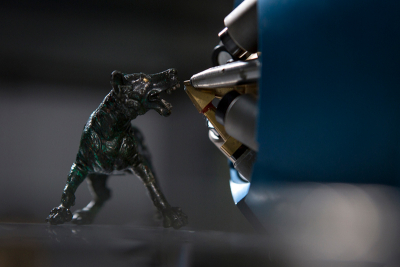
Since 1988, AGLAÉ has been operating in the Centre de Recherche et de Restauration des Musées de France (C2RMF, Palais du Louvre). It is the only particle accelerator in the world dedicated to studying heritage objects. Today, the “New AGLAÉ” installation improves that performance: automates the beam line, optimises chemical imaging on the µm scale and enables 24-hour analysis. In association with CNRS, the project is supported by the Ministry of Culture, Investissements d’Avenir, and the city of Paris. The new AGLAÉ was inaugurated on 23 November 2017 by Françoise Nyssen, Minister of Culture and Frédérique Vidal, Minister of Higher Education, Research and Innovation.
The initial instrument could not analyse fragile materials, such as biological materials like organic and inorganic pigments in painted works. These would have been visibly changed by the particle beams. The New AGLAÉ includes a more sensitive detection system that reduces the radiation these works are exposed to by a factor of 10, and creates chemical mappings simultaneously with several analytical techniques. The New AGLAÉ multi-detector, made using financing from the city of Paris, was installed in 2013.
Since then, due to issues with automation, the accelerator could only operate for 8–10 hours a day, limiting access to this tool that is in high demand by outside users, in France and throughout Europe. Thales made an innovative suggestion for stabilising and automating the accelerator and the beam line. This part of the project was financed by Investissements d’Avenir achieved as part of a collaboration between C2RMF, CNRS and Chimie ParisTech. From late 2017, the New AGLAÉ will now be able to operate 24/7.

New AGLAÉ. The magnets enabling to stabilise the beam line. © Christophe Hargoues/C2RMF/CNRS Photothèque
The first analyses will be performed on statuettes from the group of bronzes stored at the Forum Antique de Bavay (Nord) to reveal their production techniques and to enrich the exhibition that will be presented in September 2018. After that, the Celtic treasures of Lavau (Aube) will follow. Studying those will help define how to conserve and restore them.
In its role in successive European projects, AGLAÉ was the world’s first research installation entirely dedicated to cultural heritage, and accessible to European researchers. It will be a major French contribution and be one of the pillars of the E-RIHS project (European Research infrastructure for Heritage Science), included in the European roadmap of future installations.
To celebrate the relaunch of the New AGLAÉ, a colloquium takes place on 30 November in the Louvre’s auditorium. It will be an occasion to present how the instrument performs now and to review some of the landmark studies achieved with AGLAÉ, such as those on the Celtic tomb at Lavau, medieval stained glass and prehistoric bone objects coloured by ochres. Each specific case will be presented by a pair composed of an analytical scientist and an archaeologist or art historian.










